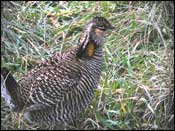Attwater's Prairie Chicken (Tympanuchus cupido attwateri)
- Other Names
- Greater Prairie Chicken
- Texas Status
- Endangered
- U.S. Status
- Endangered, Listed 3/11/1967
- Description
- The Attwater's prairie chicken is a small, brown bird about 17 inches long, with short, rounded, dark tail. Males have large orange air sacs on the sides of their necks. During mating season, males make a "booming" sound, amplified by inflating the air sacs on their necks, that can be heard 1/2 mile away.
- Life History
- Attwater's prairie chickens live on coastal prairie grasslands with tall grasses such as little bluestem, Indian grass, and switchgrass. The birds like a variety of tall and short grasses in their habitat. They gather to choose a mate in an area of bare ground or short grass where the males can be easily seen by the females. This is called a "booming groundor lek." The males dance and make a booming noise to attract the females. Hens build their nest in tallgrass and usually lay 12 eggs during nesting season. The eggs hatch in April or May. Small green leaves, seeds, and insects form the diet of the Attwater's prairie chicken. Attwater's prairie chickens live about 2-3 years in the wild.
- Habitat
- Tall grass coastal prairies are essential to the survival of this species.
- Distribution
- Attwater's prairie chickens are found only on the coastal prairies of Texas.
- Other
- Prairie chickens are endangered because the tallgrass prairie has been plowed for farmland and covered by cities. Habitat has also been lost because of heavy grazing by cattle, although some cattle ranches maintain good grassland habitat suitable for prairie chickens. Their population has declined dramatically since 1993, when an estimated 456 Attwater prairie chickens existed in the wild. In 1994, that estimate dropped to 158 birds, and by 1996, only 42 of these rare birds were left.
For more information
Visit the Attwater's Prairie Chicken National Wildlife Refuge near Eagle Lake. In addition the town of Eagle Lake holds an annual festival to celebrate the Attwater's Prairie Chicken.
See also: Attwater's birding pages for more information.
